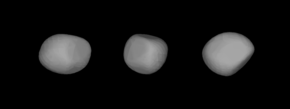 A three-dimensional model of 54 Alexandra based on its light curve A three-dimensional model of 54 Alexandra based on its light curve | |
| Discovery | |
|---|---|
| Discovered by | H. Goldschmidt |
| Discovery date | 10 September 1858 |
| Designations | |
| MPC designation | (54) Alexandra |
| Pronunciation | /ˌælɪɡˈzændrə, -ˈzɑːn-/ AL-ig-ZA(H)N-drə |
| Named after | Alexander von Humboldt (German explorer) |
| Minor planet category | Main belt |
| Adjectives | Alexandrian |
| Orbital characteristics | |
| Epoch December 31, 2006 (JD 2454100.5) | |
| Aphelion | 485.483 Gm (3.245 AU) |
| Perihelion | 326.043 Gm (2.179 AU) |
| Semi-major axis | 405.763 Gm (2.712 AU) |
| Eccentricity | 0.196 |
| Orbital period (sidereal) | 1,631.620 d (4.47 a) |
| Mean anomaly | 103.809° |
| Inclination | 11.804° |
| Longitude of ascending node | 313.446° |
| Argument of perihelion | 345.594° |
| Physical characteristics | |
| Dimensions | 160 × 135 km (± 1 km) |
| Mean diameter | 154.137 km |
| Mass | (6.16±3.50)×10 kg |
| Mean density | 3.50±2.11 g/cm |
| Synodic rotation period | 18.14 h |
| Pole ecliptic latitude | 155°±4° |
| Pole ecliptic longitude | 17°±3° |
| Geometric albedo | 0.056 |
| Spectral type | Tholen = C SMASS = C |
| Absolute magnitude (H) | 7.66 |
54 Alexandra is a carbonaceous asteroid from the intermediate asteroid belt, approximately 155 kilometers in diameter. It was discovered by German-French astronomer Hermann Goldschmidt on 10 September 1858, and named after the German explorer Alexander von Humboldt; it was the first asteroid to be named after a male.
Description
On May 17, 2005, this asteroid occulted a faint star (magnitude 8.5) and the event was observed and timed in a number of locations within the U.S. and Mexico. As a result, a silhouette profile was produced, yielding a roughly oval cross-section with dimensions of 160 × 135 km (± 1 km). The mass of the asteroid can be estimated based upon the mutually perturbing effects of other bodies, yielding an estimate of (6.16±3.50)×10 kg.
Photometric observations of this asteroid during 1990–92 gave a light curve with a period of 18.14 ± 0.04 hours and a brightness variation of 0.10 in magnitude. Alexandra has been studied by radar. It was the namesake and largest member of the former Alexandra asteroid family; a dynamic group of C-type asteroids that share similar orbital elements. Other members included 70 Panopaea and 145 Adeona. 145 Adeona was subsequently assigned to the Adeona family, with Alexandra and Panopaea being dropped.
In Popular Culture
In the Swedish film Aniara (2018) it is mentioned that 54 Alexandra is the closest celestial body which the off-course and out-of-control spacecraft will approach before it leaves the Solar System.
References
- ^ Yeomans, Donald K. "54 Alexandra". JPL Small-Body Database Browser. NASA Jet Propulsion Laboratory. Retrieved 7 April 2013.
- "Alexandra". Lexico UK English Dictionary. Oxford University Press. Archived from the original on 22 March 2020.
"Alexandra". Dictionary.com Unabridged (Online). n.d. - ^ Carry, B. (December 2012), "Density of asteroids", Planetary and Space Science, vol. 73, pp. 98–118, arXiv:1203.4336, Bibcode:2012P&SS...73...98C, doi:10.1016/j.pss.2012.03.009. See Table 1.
- ^ Belskaya, I. N.; et al. (November 1993), "Physical Studies of Asteroids. Part XXVII. Photoelectric Photometry of Asteroids 14 Irene, 54 Alexandra and 56 Melete", Astronomy and Astrophysics Supplement, vol. 101, no. 3, pp. 507–511, Bibcode:1993A&AS..101..507B.
- ^ Hanuš, J.; et al. (May 2017), "Volumes and bulk densities of forty asteroids from ADAM shape modeling", Astronomy & Astrophysics, 601: 41, arXiv:1702.01996, Bibcode:2017A&A...601A.114H, doi:10.1051/0004-6361/201629956, A114.
- "Asteroid Data Sets". Archived from the original on 17 December 2009. Retrieved 12 January 2007.
- Schmadel, Lutz D. (2003), Dictionary of Minor Planet Names (5th ed.), Springer, p. 20, ISBN 3642297188.
- D.W. Dunham, "Upcoming Asteroid Occultations", Sky & Telescope, June, 2006, p. 63.
- "Radar-Detected Asteroids and Comets". NASA/JPL Asteroid Radar Research. Retrieved 30 October 2011.
- Williams, J. G. (March 1988), "The Unusual Alexandra Family", Abstracts of the Lunar and Planetary Science Conference, vol. 19, pp. 1277–1278, Bibcode:1988LPI....19.1277W.
- Zappala, Vincenzo; et al. (December 1990), "Asteroid families. I - Identification by hierarchical clustering and reliability assessment", Astronomical Journal, vol. 100, pp. 2030–2046, 2045, Bibcode:1990AJ....100.2030Z, doi:10.1086/115658. See p. 2045 and family 44.
External links
- Lightcurve plot of 54 Alexandra, Palmer Divide Observatory, B. D. Warner (2008)
- Asteroid Lightcurve Database (LCDB), query form (info Archived 16 December 2017 at the Wayback Machine)
- Dictionary of Minor Planet Names, Google books
- Asteroids and comets rotation curves, CdR – Observatoire de Genève, Raoul Behrend
- Discovery Circumstances: Numbered Minor Planets (1)-(5000) – Minor Planet Center
- 54 Alexandra at AstDyS-2, Asteroids—Dynamic Site
- 54 Alexandra at the JPL Small-Body Database

| Minor planets navigator | |
|---|---|
| Small Solar System bodies | |||||||
|---|---|---|---|---|---|---|---|
| Minor planets |
| ||||||
| Comets | |||||||
| Other | |||||||